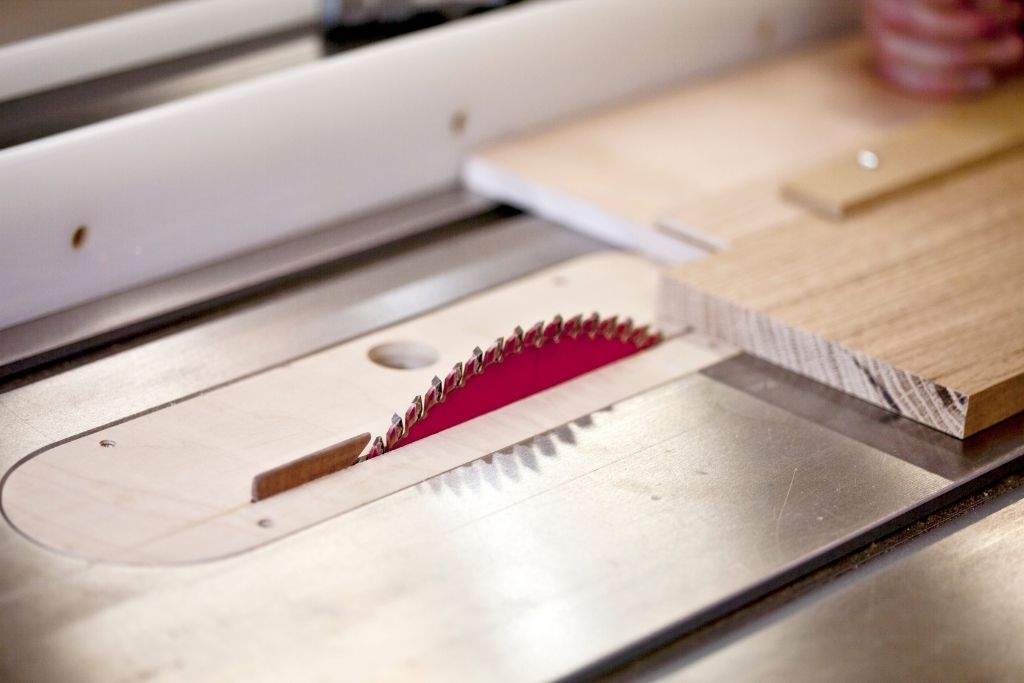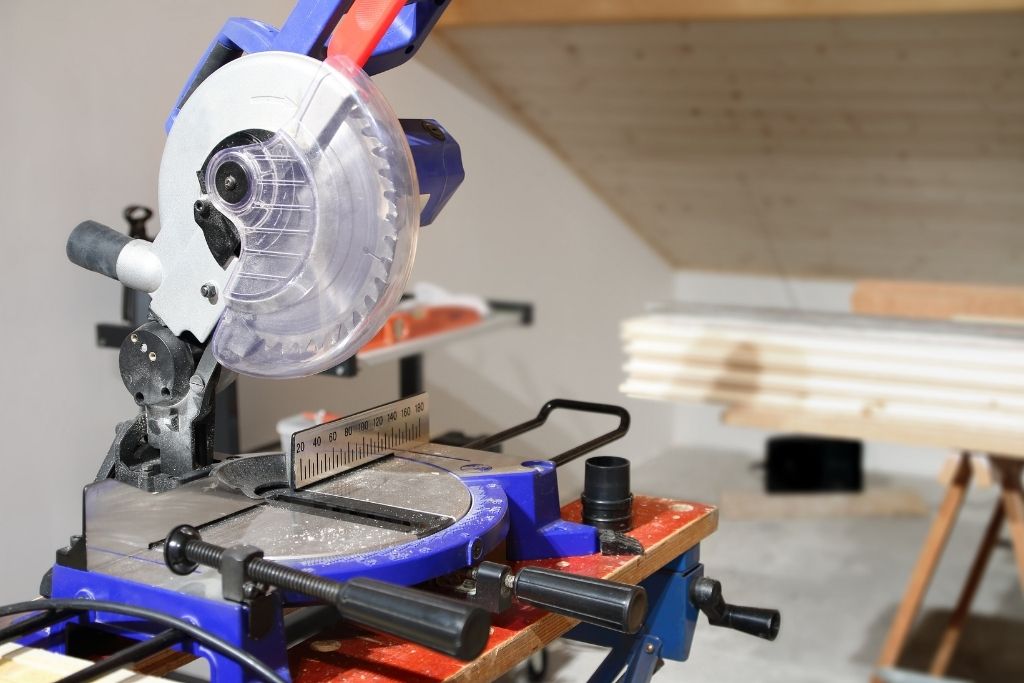
We already know table saws are the soul of most workshops. But there are also miter saws. They can get as many cuts done as the other type, and this makes things more complicated.
These power tools both have their roles in woodworking. But for first-time buyers or inexperienced, this table saw vs miter saw comparison can be confusing.
This is a breakdown of what each one does better than its competitor. You should expect that most of this choice comes down to the projects you intend to work on.
Table of Contents
Table Saw
The table saws are usually the most important purchase you can make as a woodworker. And this statement is true whether you pursue woodworking seriously as a profession or a hobby.

These machines often serve as a fixture in a workshop. They offer the cutting capabilities of many handheld tools with stability and accuracy.
You can handle a wide range of cuts with these tools, from crosscut, rip cuts, miter cuts to bevels or dado cuts. They may need some necessary accessories like miter gauges and push sticks.
But you will enjoy greater versatility with them than any other cutting tools.
They are also a perfect tool to cut sheets of plywood, thanks to their big working area. This task is impossible to get done with many smaller tools in a typical workshop.
Another highlight of the power tools is how you should never worry about the length of your cut. The spinning blade can keep cutting as long as you can feed the wood through it.
They offer a more generous working space to woodworkers than other fixed machines. Not only does it remove the limit on the cut’s length, but it also allows you to work with larger pieces.
Table saws are a powerful tool, but this also means you need some extra care. Their exposed blades are the leading cause of injuries among all stationary power tools.
A purchase like this is usually not a small investment. One of these can eat a big chunk of your woodworking budget. And it will be a serious mistake if you get it wrong or not carefully when operating them.
- Can perform variety of cuts
- Superior with rip cuts
- More efficient at cutting joints thanks to dado blades..
- Better at kerfing because of the stationary blade.
- Work with large workpieces and long cuts.
- They work well with sheet material.
- Offer many sizes and models, from mini to cabinet.
- Suitable for large woodworking projects.
- More likely to cause injuries
- They are a big investment
- Most larger ones are not portable tools.
- Require store-bought or homemade jigs for many cuts.
- Need to have skills when making precision angle cuts
Miter Saw
The Miter saws are power saws to make precision angle cuts. In simple words, they are specialized tools made for crosscuts, miter cuts, and bevels cuts.

The spinning blade, not the wood, moves in these power tools. Many models come with more than one angle adjustment. These compound miter saws allow you to cut at various angles with less effort.
Once you have set up these tools, you can quickly make the same cuts in many workpieces over and over again and complex angles.
This convenience makes them a very popular solution for carpenters when cutting door frames, picture frames, crown moldings, etc…
These tools can’t help you with other applications besides angled cuts and crosscuts. But if they are exactly what you need, they are a cheaper purchase than a more versatile tool as the table saw.
Many of them are compact enough for constant transport between sites. Even the bigger models don’t require a footprint as big as a regular table saw.
Keep in mind that the cut length on these tools depends on their blade’s size. Also, you can choose a model with a sliding mechanism to cut wider boards. But table saws are a good fit if you are in need of a very long cut.
- They can make precise angled cuts with constant repetition.
- Do not require complicated jigs.
- Many models have laser guidance to create more accurate cuts.
- More friendly to beginners.
- Not too expensive
- They are easy transports
- Limited cut length.
- Can not make rip cuts
- Worse at kerfing because of the moving saw head.
- Not suitable to cut large stocks
Difference Between Table Saw And Miter Saw
These two types of power tools share a lot of overlapped applications. The below head-to-head comparison will tell you which one is better at what.

Miter Cuts And Bevel Cuts
This is the specialization of miter saws. You set the angle, push the board against the fence, and just execute the cut in one movement. If you want a bevel cut or a compound cut, just tilt the blade.
Beginners will have an easier time making angled cuts with these tools.
The other tool table saw requires more preparation and stability from your hands. Even with a jig, controlling a workpiece is harder than controlling the miter saw head. And tuning a taper jig for bevel cuts is a skill of its own.
Crosscuts
With a proper setup, both of them can make crosscuts with high precision and repeatability. The choice mostly boils down to the size of the stock and your personal preference.
For instance, a miter saw can work wonders with some quick cuts on mid-sized stocks. It can also produce more depth out of the box too, which might not be the case with the other tool.
However, a table saw is a god-send if you have larger pieces of wood. The tool is more versatile and provides adequate support so you can make crosscuts on them safely.
Other factors like which tools you have in hand or the required precision also come into play. There is no clear winner as both of them can come in handy in different situations.
Rip Cuts
Miter saws can only rip as much as their sliding arm and base allow. Meanwhile, table saws can make extended rip cuts more effectively and with larger stocks.
Cut’s Length
Not only ripping, but table saws also have a better cut length in all types of cuts. As long as you can feed the wood to the stationary blade, the tool will do its job.
If your project calls for longer cuts, you can’t make up for it by using a wider blade or model with sliding mechanism.
Most miter saws already come with the widest blade they can support. You can only replace them for maintenance, for example, not to install a bigger blade.
This puts a serious dent in the application of these tools when you may need a wider cut for large crown molding or siding planks.
Workpiece Size
The big, flat top surface of a table saw allows it to support workpieces of much bigger sizes. Many accessories like infeed and outfeed tables can also assist in cutting long stocks or big sheets.
As miter saws are, you will run into trouble quickly with big stocks. The fixed fence and narrow base render them useless if you need more space to mount your workpiece.

Portability
It is true that both miter and table saws are available in portable and stationary forms. But most miter saws are more portable and easier to set up, either on a job site or at a fixed place in a workshop.
There are mini versions of table saws, but they are a huge step down in terms of capacity.
Precision
It is harder to cut precisely with table saws when your blade has to go completely through the wood. However, they are more accurate when the blade does not go all the way through the depth of the workpiece (joint cuts).
The reason lies in the cutting mechanism of the two types of tools. As mentioned above, a table saw blade is stationary, and the workpiece is moving. The opposite happens with the other tool.
While operating the first tool, you have to keep the workpiece steady in motion for the whole time. This is a difficult skill on its own without a proper tool and experience.
When you vary the pressure applied to the wood while pushing it, slight movements caused by the blade can result in jagged areas across the cut surface.
These small imperfections may not be a big deal on rough cuts for big projects. But your work may look clumsy and amateurish for jobs that need cleaner cuts like trimming.
That said, it isn’t impossible to achieve great precision with a table saw. You will need to have different jigs for different cuts. They require more resources and skills to use.
After all, the miter saw will have a high degree of precision and accuracy than the table saw when performing trim and angle cuts.
Versatility
There is a reason why table saws are the center of most professional and home woodworking shops.
They are an all-around tool that can make almost any cut you ask for. A miter saw can create crosscuts, miters, and bevels, but the table saw goes beyond that.
They can rip boards and even produce dado grooves easily with dado blades.
This extreme versatility makes them wildly popular among woodworkers. They are the fixture around which other tools are organized and open up many possibilities for any project.
Safety
A table saw is among the most dangerous tools in a workshop, according to the U.S. Consumer Product Safety Commission (CPSC). The number of injuries caused by the other tool pales in comparison to those associated with table saws.
This dangerous nature comes from how they work. The operator usually has to hold the wood instead of the saw. This creates a high risk of them moving their hands accidentally into the spinning blade.
Kickback is another common reason for injuries. The blade rotating at high speeds may propel the wood back to the operator into their face.
Price
Table and miter saws exist in various market ranges as well as different brands. And you can easily find a contractor-grade miter saw with more features that is much more expensive than regular table saws.
However, an entry-level miter saw usually starts at a much lower price compared to their counterparts.
You will run into a similar situation while shopping around for advanced table saws. A good table saw is often a bigger investment for woodworkers.
Conclusion
The table saw vs miter saw comparison is an interesting one. These machines have some overlapping functions. But there are also different areas only one of them excels in.
Get a table saw if:
- You are starting with woodworking and don’t know which to choose.
- You are willing to spend big money to get a versatile tool.
- Your projects need a wide array of cuts.
- You need to work with sheet materials or large stocks.
- Your work doesn’t need to move a power saw around much.
And get a miter saw if:
- Your projects need a variety of angles and precision, like trimming or crown molding.
- You don’t need to do cuts like ripping or dados.
- You work on small projects and cut small stocks
- You need to move around for work
The general idea of a table saw is an all-around woodworking tool. If you build your workshop from the ground up, it should be the first choice. You can complete all sorts of projects with them with decent results.
However, pay attention to miter saws if you need only to deal with some specific challenges. They are a more pleasant tool to deal with and don’t require as much money from your budget.


![How To Start A Woodworking Business [Ultimate Guide] How To Start A Woodworking Business [Ultimate Guide]](https://handykeen.b-cdn.net/wp-content/uploads/2021/10/woodworking-business-1-300x200.jpg)

![9 Best Pole Saws of 2023 [Ultimate Guide] 9 Best Pole Saws of 2023 [Ultimate Guide]](https://handykeen.b-cdn.net/wp-content/uploads/2021/03/best-pole-saw-300x200.jpg)

